-
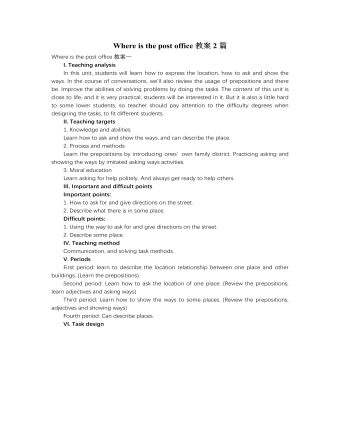
人教版新目标初中英语七年级下册Where is the post office教案2篇
Period 2 (3a----Section B 2c)Preview(Pre-task): Key points: What laAdd another information about their pen pals----their language on the cardnguage does she/he speak?She/He speaks....Does she/he have any brothers and sisters? Does she/he speak English?Preview(Pre-task): Add another information about their pen pals----their language on the cardKey points: What language does she/he speak?She/He speaks....Does she/he have any brothers and sisters? Does she/he speak English?Step 1 Revision1.Revisionand dictation of the new words 2.Revise the drills they learned yesterday.(by pairwork and grammar exercise)Step 2 Leading-inT has a conversation with one student. The conversation is following:---Do you have a pen pal?---Yes, I do.---What's your pen pal's name? ---His/Her name is....---Where is your pen pal from? ---He/She is from...---Where does he/she live? ---He/She lives in....---What language does he/she speak?He/She speaks...Write the new words on the Bb. They are following: EnglishChineseJapaneseFrenchStep 3 LearnLearn the new words with the whole class.Finish 3a with the students3b Pairwork T still does an example with one student Then the Ss practise in pairs. The example is following:--Curry Muray is my pen pal. He is from the United States.---What language does he speak?
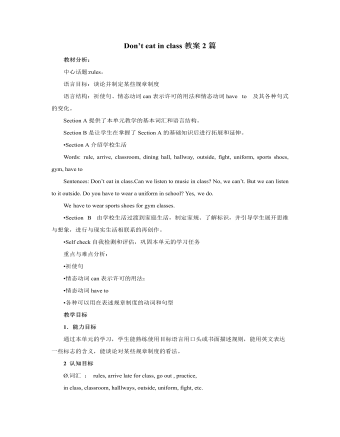
人教版新目标初中英语七年级下册Don’t eat in class教案2篇
Don’t fight. =You can’t fight. (板书,教读)教师把这些句子板书在黑板上,并请学生大声整齐地读祈使句和“can’t”句型,并让学生注意两种句型表达形式的不同和转换,“Don’t …=You can’t…”;并对学生说:These are our school rules. (板书,教读) You can’t break the school rules. Don’t break the school rules.(板书,教读)步骤3 :Practicea. T: Now, each of the students is breaking one of these rules.Please finish 1a.学生看图,完成1a的内容,检查答案并大声朗读校规。b. 听录音,完成1b,选出四位学生都违反了哪条校规;听之前,学生要读会英文名。c. 请两位学生朗读1c部分的句型;要求学生两人一组对话表演,SA扮演外校转来新生,SB告知本校校规。(学生可经过讨论,多说出他们想到的校规,不必只限于书上;教师应给予帮助)2) 第二课时(2a~4)步骤1 :warming up of revisionT: What are the rules at your school?学生使用“can”或祈使句表达各条校规;其中老师可引出“eat in the cafeteria outside”的表达。步骤2 :Practicea.T: Christina is an exchange student. She doesn’t know the rules. Let’s listen, what activities they’re talking about?学生听第一遍时,完成2a;第二遍时,完成2b;b. 请学生领读2c部分,看着2a完成的表格,理解2c活动的要求;分成小组针对2a进行问答;
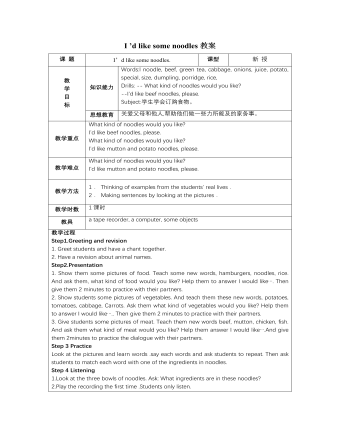
人教版新目标初中英语七年级下册I ’d like some noodles教案
教学过程Step 1: warming-up Sing a song---------“food and drink” Step 2: Revision1 Dictation2 Revise: What kind of noodles would you like?I’d like …What size bowl of noodles would you like?I’d like…Step 3: Presentation1 show pictures of food, ask students say the words.2 Students read the newspaper ad in 3a. Fill in blanks with words in the box. Then read the ad together, the teacher explains some difficult language points.3 Check the answers Step 4 PracticeAsk students to finish 3b in the same way according to 3a. Students read the short passage and fill in the blanks .At last, check the answers.Step 5 productionAsk students to write their own ad for dumplings, noodles, drinks, and other foods they know. Then ask students to read their partner’s ad. Then order food and drink from their partner.Step 6 Home workGroup work – make an ad about “food and drink”
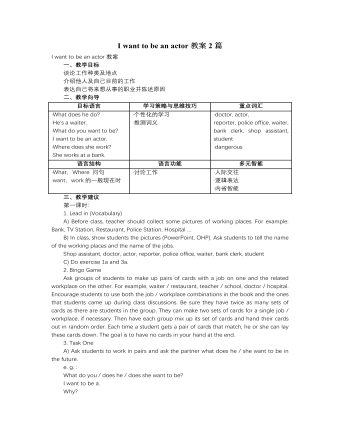
人教版新目标初中英语七年级下册I want to be an actor教案2篇
三、教学建议第一课时:1. Lead in (Vocabulary)A) Before class, teacher should collect some pictures of working places. For example: Bank, TV Station, Restaurant, Police Station, Hospital ...B) In class, show students the pictures (PowerPoint, OHP). Ask students to tell the name of the working places and the name of the jobs.Shop assistant, doctor, actor, reporter, police office, waiter, bank clerk, studentC) Do exercise 1a and 3a.2. Bingo GameAsk groups of students to make up pairs of cards with a job on one and the related workplace on the other. For example, waiter / restaurant, teacher / school, doctor / hospital. Encourage students to use both the job / workplace combinations in the book and the ones that students came up during class discussions. Be sure they have twice as many sets of cards as there are students in the group. They can make two sets of cards for a single job / workplace, if necessary. Then have each group mix up its set of cards and hand their cards out in random order. Each time a student gets a pair of cards that match, he or she can lay these cards down. The goal is to have no cards in your hand at the end.3. Task OneA) Ask students to work in pairs and ask the partner what does he / she want to be in the future.e. g. :What do you / does he / does she want to be?I want to be a.Why?Because it's (adj).B) Vocabulary: Section B, 1a4. Homework 1.2.
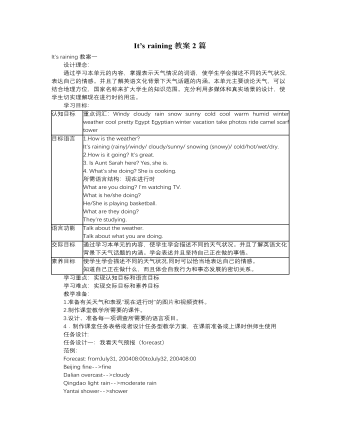
人教版新目标初中英语七年级下册It’s raining教案2篇
1 Each group choose one place to describe and what you are doing in it Choose one place, and describe what they are doing 2 Move around the room and give suggestions Talk about it and write it down 3 Ask one to show their works and act it Choose one of each group to make a report 4 Evaluate the best group and the best reporter Choose the best one Homework Ask your friends their ideal place and write about it教学反思:新课程标准中强调学生在课堂中的主体地位,在综合课中他们的主体地位就更加突出。在各个活动中给不同程度的学生不同层次的任务,让各层面的学生都有表现发挥的机会,从而产生对英语的兴趣。使用照片图片多媒体来辅助教学,效果更好。同时让了解其他国家风景,风俗的同学介绍ideal place,增加学生的背景知知识,实现跨学科交流的目的。教案点评:采用任务型教学模式,在各个活动中给不同程度的学生不同层次的任务,让各层面的学生都有表现发挥的机会,从而产生对英语的兴趣。使用照片图片多媒体来辅助教学,效果更好。让了解其他国家风景,风俗的同学介绍ideal place,增加学生的背景知识,实现跨学科交流的目的。

人教版新目标初中英语七年级下册Where is your pen pal from教案
2.1Match the country with the language.Step II Reading3a? let the students read the letter fast and answer the questions.? Let the students ask more questions about the letter as possible as the can.Step III Writing3b.Step IV. Pairwork2cStep V Listening2a, 2bStep V. HomeworkExercises book(1) P3Exercises book (2) P3Period FourStep I . Dictate the words and sentences in Unit1.Step II. Self-checkStep III. Check the answers for Exercises book in the unit.Step IV. Home workRevise and preparation for unit 2.教学反思:通过本单元的学习,学生基本可以谈论人们的国籍,居住城市及其所说的语言,通过书信方式去介绍自己并寻找笔友。但在涉及到国外的一些城市时,学生对这方面的知识相对欠缺,能介绍的城市并不多,也反应出学生课前预习不充分,这跟学生学习条件也有关,大多数学生无法通过网络获取所需信息。因此,在以后的教学中要多指导学生通过计算机网络获取信息,拓宽知识面。
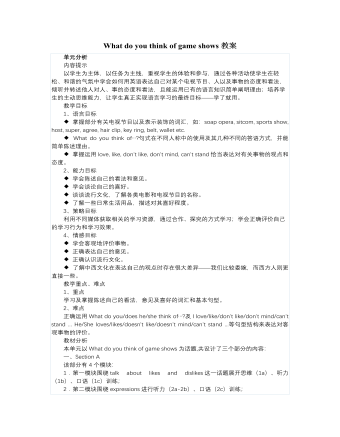
人教版新目标初中英语七年级下册What do you think of game shows教案
五、教学Section B-2c1. Pair work: What do you think of the belt/sunglasses/…? What does your father/mother/… think of your scarf/belt…?2. Group work(1). Teacher shows some different kinds of school uniforms (制服)and asks : “ What do you think of your school uniforms? If you have a chance to choose your school uniforms, what kind would you like to choose?”(2). Discuss in groups.(3).Get some Ss to report in class.说明:这一步旨在让学生运用已有的语言知识谈论对事物的看法和意见,并简单阐明理由,培养学生的主动思维能力和运用英语的能力。六、教学拓展调查电视节目的收视率任务:调查你周围的人对现在各种电视节目的反响。活动过程:1.教师布置任务,让学生调查周围的人(包括他的亲戚朋友和邻居)喜欢收看哪方面的电视节目。2.学生进行调查活动,运用本单元所学的句型What do you think of….? (Why?)What's your favorite game shows?What do you think of talk show?I doesn’t mind it.I like it.I love it.I can’t stand it.3.记录下排在前10位的TV Program,填写调查表,比较其收视率。

人教版新目标初中英语七年级下册Where did you go on vacation教案
句型: Where did you go on vacation? I went to summer camp.Did she go to Central Park?Yes,she did.No, she didn’t语法:一般过去时特殊疑问句、一般疑问句及肯、否定回答。课时安排4课时第一课时:Section A:la,1b,lc,2a,2b,2c 第二课时:Section A:3a,3b,4第三课时:Section B:1,2a,2b,2c第四课时:Section B:3a,3b,3c,4 and Self Check第一课时教学目标掌握描写假期生活的形容词。假期里自己所做事情的简单表达。谈论假期做的事情及当时情况。谈论假期时旅游的天气,旅游者以及食物等。教学过程一、导入播放一首英文歌曲:Let’s travel 说明:通过让学生听节奏欢快迪斯尼英语歌曲Let’s travel.引入本节课谈论的话题vacation and travel. 让歌曲使学生的思维活跃,增强课堂气氛,激发学生提高学习英语的兴趣。T:How is the trip ?Ss : It’s pretty good/ happy/exciting /relaxing/busy/dangerous/ fantastic说明:这个问题是为了操练形容词。建议让多个Ss作答。鼓励他们用不同的形容词。上述个别形容词本应在第二课时中出现,但可以在warming-up中第一次非正式出现。这些形容词也可在老师的评价语中适时出现,以加深学生对词汇的印象。
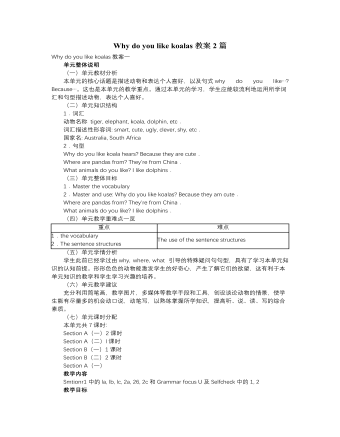
人教版新目标初中英语七年级下册Why do you like koalas教案2篇
单元整体说明(一)单元教材分析本单元的核心话题是描述动物和表达个人喜好,以及句式why do you like…? Because…。这也是本单元的教学重点。通过本单元的学习,学生应能较流利地运用所学词汇和句型描述动物,表达个人喜好。(二)单元知识结构1.词汇动物名称 tiger, elephant, koala, dolphin, etc.词汇描述性形容词: smart, cute, ugly, clever, shy, etc.国家名: Australia, South Africa2.句型Why do you like koala hears? Because they are cute.Where are pandas from? They're from China.What animals do you like? I like dolphins.(三)单元整体目标1.Master the vocabulary2.Master and use: Why do you like koalas? Because they am cute.Where are pandas from? They're from China.What animals do you like? I like dolphins.(四)单元教学重难点一览(五)单元学情分析学生此前已经学过由why, where, what 引导的特殊疑问句句型,具有了学习本单元知识的认知前提。形形色色的动物能激发学生的好奇心,产生了解它们的欲望,这有利于本单元知识的教学和学生学习兴趣的培养。
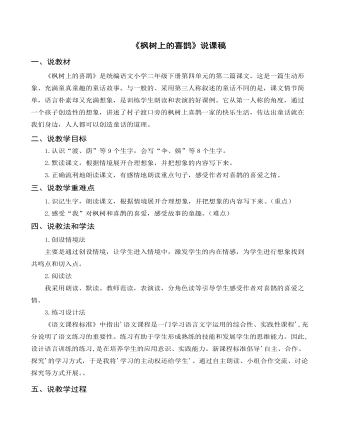
(说课稿)《枫树上的喜鹊》部编人教版二年级上册语文
二、说教学目标1.认识“渡、荫”等9个生字,会写“伞、姨”等8个生字。 2.默读课文,根据情境展开合理想象,并把想象的内容写下来。? 3.正确流利地朗读课文,有感情地朗读重点句子,感受作者对喜鹊的喜爱之情。三、说教学重难点1.识记生字,朗读课文,根据情境展开合理想象,并把想象的内容写下来。(重点) 2.感受“我”对枫树和喜鹊的喜爱,感受故事的童趣。(难点)四、说教法和学法1.创设情境法主要是通过创设情境,让学生进入情境中,激发学生的内在情感,为学生进行想象找到共鸣点和切入点。? 2.阅读法我采用朗读、默读。教师范读,表演读,分角色读等引导学生感受作者对喜鹊的喜爱之情。3.练习设计法《语文课程标准》中指出'语文课程是一门学习语言文字运用的综合性、实践性课程',充分说明了语文练习的重要性。练习有助于学生形成熟练的技能和发展学生的思维能力。因此,设计语言训练的练习,是在培养学生的应用意识、实践能力。新课程标准倡导'自主、合作、探究'的学习方式,于是我将'学习的主动权还给学生'。通过自主朗读、小组合作交流、讨论探究等方式开展。
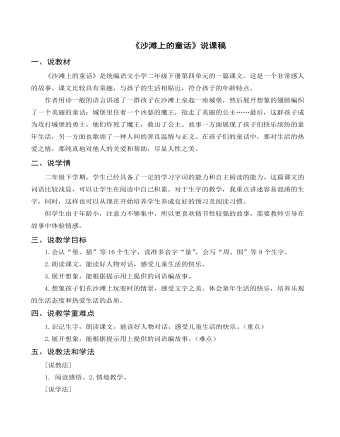
(说课稿)《沙滩上的童话》部编人教版二年级上册语文
一、说教材《沙滩上的童话》是统编语文小学二年级下册第四单元的一篇课文。这是一个非常感人的故事,课文比较具有童趣,与孩子的生活相贴近,符合孩子的年龄特点。 作者用诗一般的语言讲述了一群孩子在沙滩上垒起一座城堡,然后展开想象的翅膀编织了一个美丽的童话:城堡里住着一个凶恶的魔王,抢走了美丽的公主……最后,这群孩子成为攻打城堡的勇士,他们炸死了魔王,救出了公主。故事一方面展现了孩子们快乐缤纷的童年生活,另一方面也歌颂了一种人间的善良温情与正义。在孩子们的童话中,那对生活的热爱之情,那纯真地对他人的关爱和帮助,尽显人性之美。二、说学情二年级下学期,学生已经具备了一定的学习字词的能力和自主阅读的能力。这篇课文的词语比较浅显,可以让学生在阅读中自己积累。对于生字的教学,我重点讲述容易混淆的生字,同时,这样也可以从现在开始培养学生养成良好的预习及阅读习惯。 但学生由于年龄小,注意力不够集中,所以更喜欢情节性较强的故事,需要教师引导在故事中体验情感。

(说课稿)识字《 “贝”的故事》部编人教版二年级上册语文
一、说教材《“贝”的故事》是统编语文小学二年级下册第三组识字单元第三篇课文。这篇课文由贝类引入,讲述了古人对贝的喜爱,讲解了一些由“贝”衍生出的汉字,如:赚、赔、购、贫、货等,让学生了解汉字的起源:刚开始是用具体的事物帮助记忆、交流思想,然后依靠集体的智慧,经过时间的锤炼,就形成了汉字。二、说学情二年级的学生对汉字的起源不了解,但这一课形象生动地讲解了与“贝”相关的汉字,学生易于接受。因此,教师可安排学生在课前搜集汉字知识,在课外拓展汉字知识,这样,学生对于汉字的起源及相关知识会有一个系统化的了解。三、说教学目标1.认识“甲、骨”等16个生字;会写“贝、壳”等9个生字。2.默读课文,了解贝字的起源,贝的作用以及字形字义。3.进一步了解汉字的意思,与偏旁有关的特点。4.通过学习,感受汉语言文字和中华文化的博大精深,源远流长。
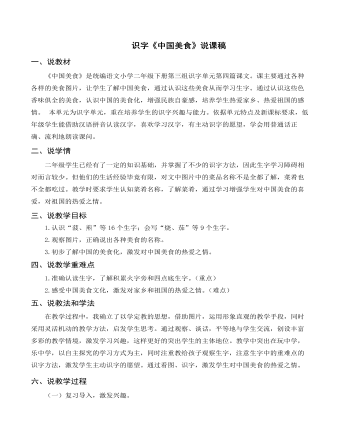
(说课稿)识字《中国美食》部编人教版二年级上册语文
一、说教材《中国美食》是统编语文小学二年级下册第三组识字单元第四篇课文。课主要通过各种各样的美食图片,让学生了解中国美食,通过认识这些美食从而学习生字。通过认识这些色香味俱全的美食,认识中国的美食化,增强民族自豪感,培养学生热爱家乡、热爱祖国的感情。 本单元为识字单元,重在培养学生的识字兴趣与能力。依据单元特点及新课标要求,低年级学生能借助汉语拼音认读汉字,喜欢学习汉字,有主动识字的愿望,学会用普通话正确、流利地朗读课问。二、说学情二年级学生已经有了一定的知识基础,并掌握了不少的识字方法,因此生字学习障碍相对而言较少。但他们的生活经验毕竟有限,对文中图片中的菜品名称不是全都了解,菜肴也不全都吃过。教学时要求学生认知菜肴名称,了解菜肴,通过学习增强学生对中国美食的喜爱,对祖国的热爱之情。
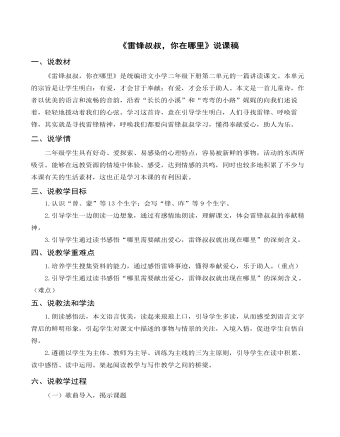
(说课稿)《雷锋叔叔,你在哪里》部编人教版二年级上册语文
三、说教学目标1.认识“曾、蒙”等13个生字;会写“锋、昨”等9个生字。2.引导学生一边朗读一边想象,通过有感情地朗读,理解课文,体会雷锋叔叔的奉献精神。3.引导学生通过读书感悟“哪里需要献出爱心,雷锋叔叔就出现在哪里”的深刻含义。四、说教学重难点 1.培养学生搜集资料的能力,通过感悟雷锋事迹,懂得奉献爱心,乐于助人。(重点)2.引导学生通过读书感悟“哪里需要献出爱心,雷锋叔叔就出现在哪里”的深刻含义。(难点)五、说教法和学法1.朗读感悟法,本文语言优美,读起来琅琅上口,引导学生多读,从而感受到语言文字背后的鲜明形象,引起学生对课文中描述的事物与情景的关注,入境入情,促进学生自悟自得。2.遵循以学生为主体、教师为主导、训练为主线的三为主原则,引导学生在读中积累、读中感悟、读中运用。架起阅读教学与写作教学之间的桥梁。
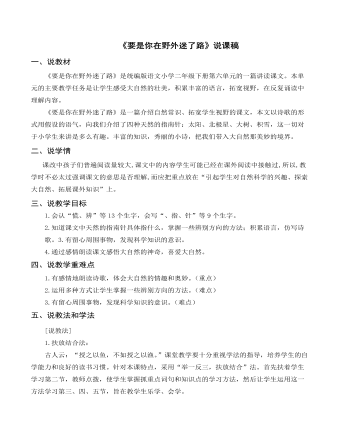
(说课稿)《要是你在野外迷了路》部编人教版二年级上册语文
六、说教学过程(一)创设情境,激趣导入 一堂课的开始,为了使学生尽快地进入学习状态,在情境创设中,应该做到新颖,要让学生感受到一种新的情境,从而产生好奇心,达到集中注意力的目的。教学开始,我首先创设情境,提出了两个问题:1.如果你在大街上迷路了,你会怎么做?2.如果你在野外迷了路,你又会怎么做?【设计意图】这两个问题的提出让学生区分在不同的地点迷了路要用不同的方法。然后我顺势导入课文:我们来学习课文,看看如果在野外迷了路,有什么办法分辨方向。(二)初读课文,整体感知 1.让学生自由读课文,要求把字音读准,把句子读通顺。然后老师范读一遍,让学生注意听老师是怎么读的,如字音、节奏等。2.再次自由读课文,按着老师的方法读诗歌,然后把本课的生字读一遍。【设计意图】这样,学生对于课文的生字和大概内容就有了一个整体印象,培养了他们的自学能力。
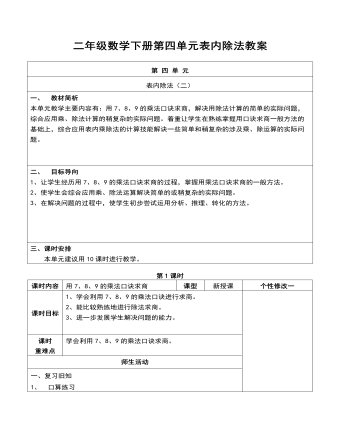
二年级数学下册第四单元表内除法教案
1、 谈话引入新课六一快到了。小朋友们在老师的带领下忙着布置自己的教室呢!可是他们遇到了一些数学上的问题,你能帮他们一快解决吗?2、教学例1。(1)、投影出示主题图引导学生仔细观察。说说他们遇到了什么问题?(2)、引导学生解决问题并列出算式。板书:56÷8(3)、引导学生得出算式的商。问:你是怎么计算的?(想乘算除)(4)、学生独立解决:要是挂7行呢?你能够解决吗?学生说出自己的计算结果,并把求商的过程跟大家说一说。2、 小结:在今天的学习中我们不仅帮小朋友们解决了数学问题,而且还进一步学会了利用乘法口诀来求商。在以后的除法中只要大家能够熟记口诀,就能很快算出除法的商了。
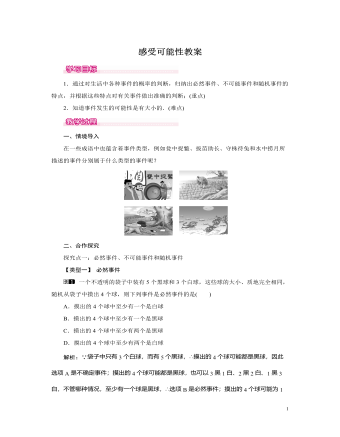
北师大初中七年级数学下册感受可能性教案
一个不透明的袋子中装有5个黑球和3个白球,这些球的大小、质地完全相同,随机从袋子中摸出4个球,则下列事件是必然事件的是( )A.摸出的4个球中至少有一个是白球B.摸出的4个球中至少有一个是黑球C.摸出的4个球中至少有两个是黑球D.摸出的4个球中至少有两个是白球解析:∵袋子中只有3个白球,而有5个黑球,∴摸出的4个球可能都是黑球,因此选项A是不确定事件;摸出的4个球可能都是黑球,也可以3黑1白、2黑2白、1黑3白,不管哪种情况,至少有一个球是黑球,∴选项B是必然事件;摸出的4个球可能为1黑3白,∴选项C是不确定事件;摸出的4个球可能都是黑球或1白3黑,∴选项D是不确定事件.故选B.方法总结:事件类型的判断首先要判断该事件发生与否是不是确定的.若是确定的,再判断其是必然发生的(必然事件),还是必然不发生的(不可能事件).若是不确定的,则该事件是不确定事件.
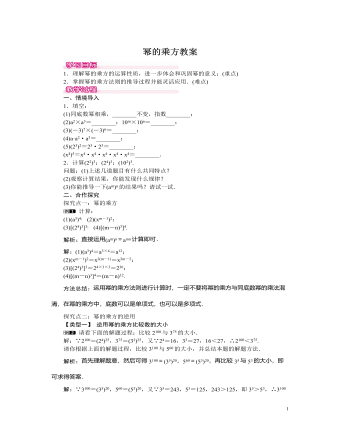
北师大初中七年级数学下册幂的乘方教案
方法总结:本题考查了幂的乘方的逆用及同底数幂的乘法,整体代入求解也比较关键.【类型三】 逆用幂的乘方结合方程思想求值已知221=8y+1,9y=3x-9,则代数式13x+12y的值为________.解析:由221=8y+1,9y=3x-9得221=23(y+1),32y=3x-9,则21=3(y+1),2y=x-9,解得x=21,y=6,故代数式13x+12y=7+3=10.故答案为10.方法总结:根据幂的乘方的逆运算进行转化得到x和y的方程组,求出x、y,再计算代数式.三、板书设计1.幂的乘方法则:幂的乘方,底数不变,指数相乘.即(am)n=amn(m,n都是正整数).2.幂的乘方的运用幂的乘方公式的探究方式和前节类似,因此在教学中可以利用该优势展开教学,在探究过程中可以进一步发挥学生的主动性,尽可能地让学生在已有知识的基础上,通过自主探究,获得幂的乘方运算的感性认识,进而理解运算法则
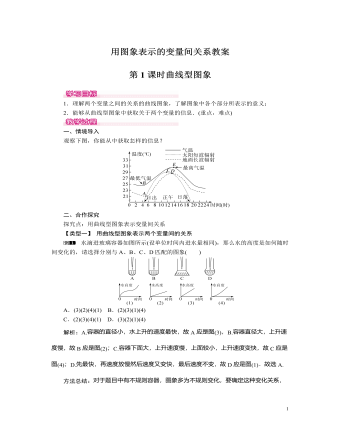
北师大初中七年级数学下册曲线型图象教案
解析:横轴表示时间,纵轴表示温度.温度最高应找到图象的最高点所对应的x值,即15时,A对;温度最低应找到图象的最低点所对应的x值,即3时,B对;这天最高温度与最低温度的差应让前面的两个y值相减,即38-22=16(℃),C错;从图象看出,这天0~3时,15~24时温度在下降,D对.故选C.方法总结:认真观察图象,弄清楚时间是自变量,温度是因变量,然后由图象上的点确定自变量及因变量的对应值.三、板书设计1.用曲线型图象表示变量间关系2.从曲线型图象中获取变量信息图象法能直观形象地表示因变量随自变量变化的变化趋势,可通过图象来研究变量的某些性质,这也是数形结合的优点,但是它也存在感性观察不够准确,画面局限性大的缺点.教学中让学生自己归纳总结,回顾反思,将知识点串连起来,完成对该部分内容的完整认识和意义建构.这对学生在实际情境中根据不同需要选择恰当的方法表示变量间的关系,发展与深化思维能力是大有裨益的
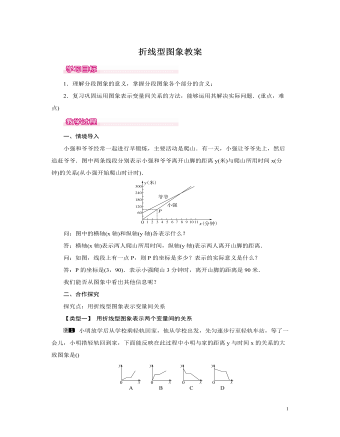
北师大初中七年级数学下册折线型图象教案
解析:(1)根据图象的纵坐标,可得比赛的路程.根据图象的横坐标,可得比赛的结果;(2)根据乙加速后行驶的路程除以加速后的时间,可得答案.解:(1)由纵坐标看出,这次龙舟赛的全程是1000米;由横坐标看出,乙队先到达终点;(2)由图象看出,相遇是在乙加速后,加速后的路程是1000-400=600(米),加速后用的时间是3.8-2.2=1.6(分钟),乙与甲相遇时乙的速度600÷1.6=375(米/分钟).方法总结:解决双图象问题时,正确识别图象,弄清楚两图象所代表的意义,从中挖掘有用的信息,明确实际意义.三、板书设计1.用折线型图象表示变量间关系2.根据折线型图象获取信息解决问题经历一般规律的探索过程,培养学生的抽象思维能力,经历从实际问题中得到关系式这一过程,提升学生的数学应用能力,使学生在探索过程中体验成功的喜悦,树立学习的自信心.体验生活中数学的应用价值,感受数学与人类生活的密切联系,激发学生学数学、用数学的兴趣

